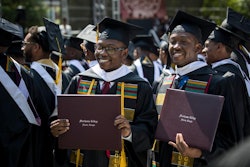A disproportionate percentage of degrees from proprietary colleges go to Black and Hispanic graduates. While Black students earned 8.9 percent of bachelor’s degrees in the United States during the 2004-2005 academic year, they accounted for 15 percent (20,070) of the degrees conferred by proprietaries. And while Blacks earned 11.3 percent of associate degrees that year, they got 18.1 percent (9,990) from the for-profit sector, according to data in the National Center for Education Statistics’ latest report, Postsecondary Institutions in the United States: Fall 2005 and Degrees & Other Awards Conferred: 2004-05: First Look.
A similar pattern occurs for Hispanics, who earned 6.3 percent of bachelor’s degrees, but 9.6 percent (12,810) of the for-profit degrees that year. They also earned 10.4 percent of associate degrees but 14.2 percent (7,864) from for-profits.
“The career colleges have long sought out minority students,” says Mark E. Robbins, vice president for membership and communications at the Career College Association. “It’s largely a population not well served by traditional higher education.” Professional schools allow these people to get their degrees and into their career ladders more quickly than traditional colleges that require all sorts of other courses.
A study last year by Howard University Professor Roy L. Beasley found that “in business and computer-related studies at both the bachelor’s and master’s levels, a number of for-profit institutions of higher learning have assumed roles traditionally associated with historically Black colleges and universities as producers of disproportionately large percentages of Black graduates.”
Meanwhile, the U.S. Census Bureau recently reported in “School Enrollment — Social and Economic Characteristics of Students: October 2005” that 6.2 percent of the population (17.8 million students) attended college at the time. Asians attended at a much higher rate than other racial categories, (9.9 percent, or 1.2 million). Almost 2.3 million Blacks, or 6.6 percent of the Black population, were enrolled in higher education that year. White students were only slightly behind, at 6 percent (13.5 million). Only 4.9 percent of Hispanics (1.9 million) were enrolled.
First and second-generation Americans attended at roughly the same rate as the children of more-entrenched families. Amongst the foreign-born population, 5.9 percent, or 2.1 million students, attended, as did 6.4 percent (4 million) of their children.
— Charles Pekow
© Copyright 2005 by DiverseEducation.com


















